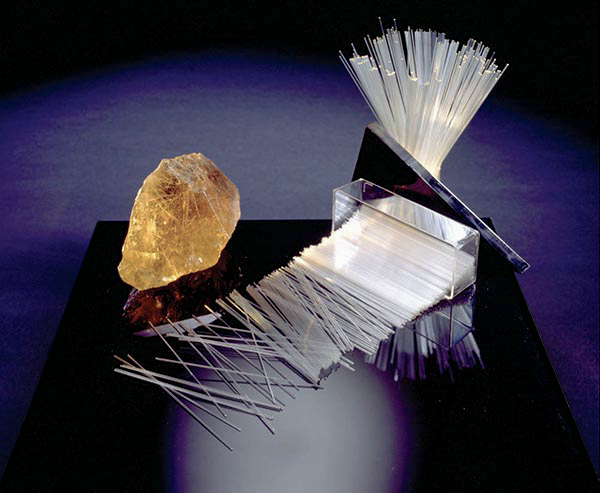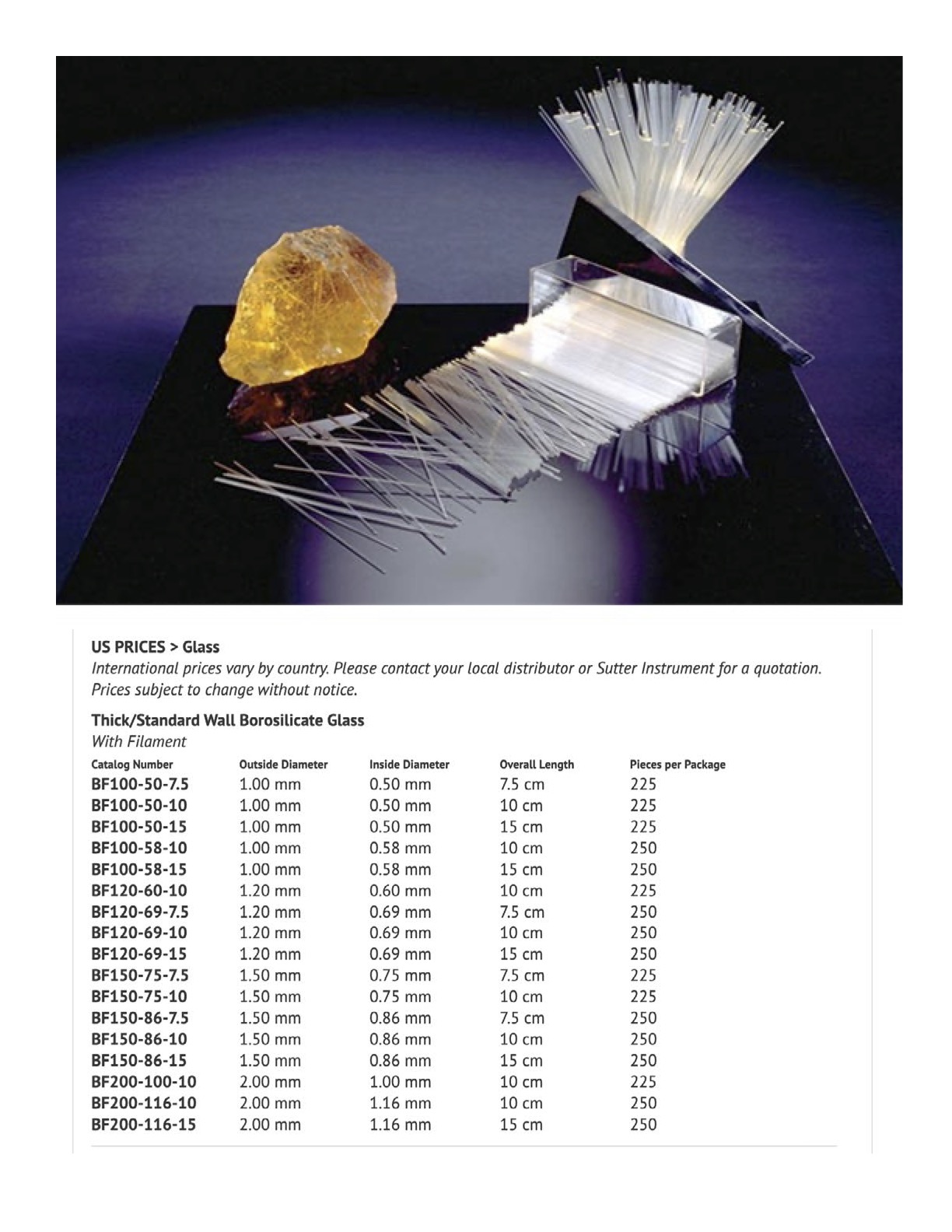Sutter Glass and Filaments

Fire Polishing
All borosilicate and aluminosilicate capillary glass offered by Sutter Instrument have fire-polished ends. This process eliminates any sharp edges, making it easier to insert into holders, and does not affect the electrical or mechanical properties of the glass.
Custom Pipettes
Sutter Instrument can make custom pipettes and microtools not commonly available from other pipette manufacturers. For example, we make custom pre-pulled beveled pipettes for microinjection. The custom pipettes are considered non-sterile and are manufactured for research applications and non-human use. Please contact us for further details.
Sizes
Sutter Instrument capillary tubing is available in a broad range of wall thickness which allows you to select the size necessary for your application. The ratios of inside diameter to outside diameter typically run between 0.5mm and 0.75mm with the lower value being referred to as thick wall tubing and the top of the range as thin wall tubing. All other factors being equal, the thicker wall capillaries produce pipettes with longer tapers and smaller tips which make it more suitable for intracellular microelectrodes. These thicker wall pipettes tend to reduce the noise contributions due to capacitance which makes them more suitable for patch clamp pipettes. Thinner wall tubing allows for larger pore openings which make it ideal for microinjection needles and low resistance microelectrodes.
Filamented Glass
Filamented glass has a small rod of glass annealed to the inner wall and this rod (filament of glass) creates the capillary action required to back-fill the pipette with solution. If the resulting pipette tip is under 1µl and being used for microinjection or being used for recording, we recommend “filamented-glass”. The filament in the glass not only provides capillary action for quick filling of the micropipette, it also helps to reduce the incidence of air bubbles when introducing solution into the pipette.
Glass Composition
Borosilicate (CORNING 7740)
The most commonly used glass is borosilicate. Sutter Instrument offers only TYPE I-CLASS A borosilicate as described by ASTM Standard 3.1.2*. This glass softens at 821 degrees Celsius and, as it is pulled, maintains its ratio of inside diameter to outside diameter over the total taper length. Borosilicate softens at a lower temperature than our other glasses and has a wider working range. These unique properties allow for a greater variety of shapes used in microelectrodes, patch pipettes, microinjection needles and, in the case of solid rod, chromosome dissection tools.
Aluminosilicate (SCHOTT 8252)
Aluminosilicate softens at a higher temperature (935 degrees Celsius) than borosilicate and is workable over a much narrower range. It has a tendency to continuously thin out as it is drawn which allows extremely fine tips with very short tapers. For example, we have pulled aluminosilicate tips in the 20-30 nanometer range with taper lengths of 5-6 mm. Its resistivity is several orders of magnitude higher than borosilicate, thus reducing leakage currents when used in ion-selective micropipettes. Aluminosilicate is harder than borosilicate which results in a pipette that is more suitable for penetrating tough tissues.
Quartz (HERAEUS HSQ300)
The finest and purest glass available is quartz. It is superior to all other glasses in its mechanical, electrical and optical qualities. It has the lowest dielectric constant, the lowest loss factor and the highest volume resistivity making it ideal for patch clamp recording. Its chemical purity virtually eliminates leakage of ions** and by using quartz in single channel patch clamp recordings the lowest background noise levels have been achieved***. Due to its high melting point, it cannot be pulled on conventional pullers. However, it can be pulled easily with the Sutter CO2 laser-based P-2000.
* ASTM Designation E438-90 – April 1990
** Zuazaga C., Steinacker A. Patch-clamp recording of ion channels: Interfering effects of patch pipette glass. News in Physiological Sciences: International Union of Physiological Sciences and the American Physiological Society: 5:155-158, August 1990
*** Rae, James L., Levis Richard A. A Method for exceptionally low noise single channel recordings. Pflügers Archive; European Journal of Physiology:420:618-620, Springer-Verlag 1992
Sutter Tech Note
What is filamented glass and who needs it?
“When buying filamented glass, the “filament” refers to a ~160 micron rod of glass that is annealed to the inner wall of the tubing. This rod of glass in the lumen acts as a wick to create capillary action which allows for easy back-filling of solution into the pipette tip and taper. When back-filling a patch pipette, the tip and most of the taper will fill within 30-60 seconds. When back-filling a sharp and long microelectrode or a microinjection pipette, the tip and most of the taper will fill within 2-3 minutes.
As your capillary glass is heated and drawn out on your Sutter Micropipette Puller to create a microelectrode or microinjection pipette, the inner diameter of the glass and this filament will gradually reduce in size. If you make a pipette that has a 0.5µm tip ID, this rod (a.k.a. filament) inside the glass will end up being around 80 nanometers at the tip.
Any time you are making a micropipette that has a tip at or under 3µm, as needed when performing microinjection or electrophysiology applications, it is best to buy filamented glass. Without a filament, back-filling pipettes can become difficult to impossible and this will most often cause poor filling and introduce air bubbles within the solution of the pipette.
The glass is filamented if the Sutter Item number for Borosilicate, Aluminosilicate or Quartz glass starts with BF, AF or QF. For Example, BF150-86-10 indicates the following: Borosilicate Glass with Filament, 1.5mm outer diameter, 0.86mm inner diameter and a 10cm in length.”
– By Adair Oesterle



